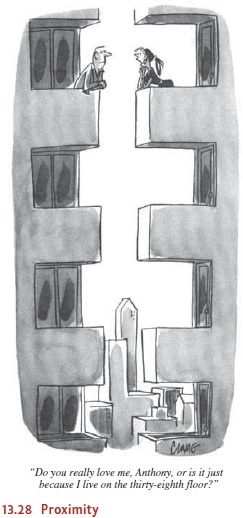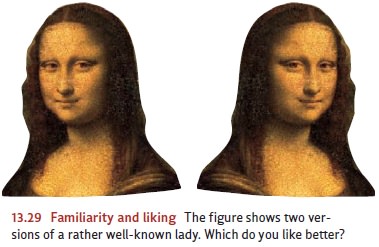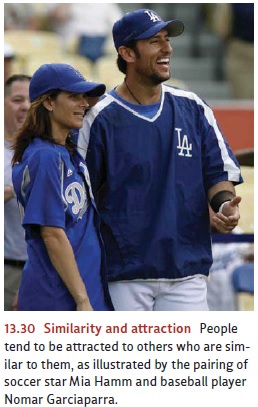Chapter: Psychology: Social Psychology
Social Relations: Attraction
Attraction
Acts of aggression or acts of helping often involve isolated incidents. Someone cuts you off in traffic, and you angrily honk your horn; a stranger on a street corner asks you for a few coins, and you do (or perhaps don’t) give some. Other forms of social relationship are more enduring—and can color your life for many years. These long-lasting relation-ships include friendship and the exciting, comforting, and sometimes vexing relation that we call love.
What
initially draws people together as friends or lovers? How do we win someone’s
affections? How do close relationships change over the long term?
ATTRACTIVENESS
Common
sense tells us that physical appearance is an important determinant of attrac-tion,
and formal evidence confirms that point. In one study, freshmen were randomly
paired at a dance and later asked how much they liked their partner and whether
he or she was someone they might want to date. After this brief encounter, what
mainly determined each person’s desirability as a future date was his or her
physical attractive-ness (Walster, Aronson, Abrahams, & Rottman, 1966).
Similar results were found among clients of a commercial dating service who
selected partners based on files that included a photograph, background
information, and details about interests, hobbies, and personal ideals. When it
came down to the actual choice, the primary determinant was the photograph (S.
K. Green, Buchanan, & Heuer, 1984).
Physically
attractive individuals also benefit from the common tendency to associate
physical attractiveness with a variety of other positive traits, including
intelligence, happiness, and good mental health (e.g., Bessenoff & Sherman,
2000; Dion, Berscheid, & Walster, 1972; Eagly, Ashmore, Makhijani, &
Longo, 1991; Feingold, 1992; Jackson, Hunter, & Hodge, 1995; Langlois et
al., 2000). This is, in fact, part of a larger pattern sometimes referred to as
the halo effect, a term that refers
to our tendency to assume that people who have one good trait are likely to
have others (and, conversely, that people with one bad trait are likely to be
bad in other regards as well). In some cases, there may be a kernel of truth in
this pattern of beliefs, but unmistakably the “halo” extends farther than it
should (Anderson, Adams, & Plaut, 2008). For example, people seem to make
judgments about how competent someone
is based only on facial appearance, and so, remarkably, judgments about
appearance turn out to be powerful predictors of whom people will vote for in
U.S. congressional elections (Todorov, Mandisodza, Goren, & Hall, 2005).
PROXIMITY
A
second important factor in determining attraction is sheer proximity (Figure
13.28). By now, dozens of studies have shown that if you want to predict who
will make friends with whom, the first thing to ask is who is nearby. Students
who live next to each other in a dormitory or sit next to each other in classes
develop stronger relations than those who live or sit only a bit farther away
(Back, Schmukle, & Egloff, 2008). Similarly, members of a bomber crew
became much friendlier with fellow crew mem-bers who worked right next to them
than with others who worked only a few feet away (Berscheid, 1985).
In
this case, what holds for friendship also holds for mate selection. The
statistics are rather impressive. For example, one classic study considered all
the couples who took out marriage licenses in Columbus, Ohio, during the summer
of 1949. Among these couples, more than half were people who lived within 16
blocks of each other when they went out on their first date (Clarke, 1952).
Much the same holds for the

probability
that an engagement will ultimately lead to marriage; the farther apart the two
live, the greater the chance that the engagement will be broken off (Berscheid
& Walster, 1978).
Why
is proximity so important? Part of the answer simply involves logistics rather
than psychology. You cannot like someone you have never met, and the chances of
meeting that someone are much greater if he is nearby. In addition, even if you
have met someone and begun a relationship, distance can strain it. Indeed, the
prospect of commuting and of communicating only by email and phone calls
corrodes many marriages and ends many high school romances.
Beyond
these obvious points, though, it also turns out that getting to know some-one
makes him more familiar to you, and
familiarity in turn is itself a source of attrac-tion. Indeed, whether we are
evaluating a word in a foreign language, a melody, or the name of a commercial
product, studies indicate that the more often something is seen or heard, the
better it will be liked (Coates, Butler, & Berry, 2006; Moreland &
Zajonc, 1982; Zajonc, 1968; also see Norton, Frost, & Ariely, 2007).
Familiarity probably plays an important role in determining what we feel about
other people as well. For example, people judge photographs of strangers’ faces
to be more likable the more often they have seen them (Jorgensen & Cervone,
1978). Likewise, which is preferred—a photo of a familiar face, or a
mirror-image of that photo? If familiarity is the critical variable, our
friends should prefer a photograph of our face to one of its mirror image,
since they have seen the first much more often than the second. But we
ourselves should prefer the mirror image, which for us is far more familiar.
These predictions turn out to be correct (Mita, Dermer, & Knight, 1977;
Figure 13.29).

SIMILARITY
Another
important factor that influences attraction is similarity, but in which direction does the effect run? Do “birds
of a feather flock together” or—perhaps in analogy with magnets—do “opposites
attract”? Birds have more to teach us in this matter than do magnets—the
evidence suggests that, in general, people tend to like others who are similar
to themselves (Figure 13.30). For example, elementary school students prefer
other children who perform about as well as they do in academics, sports, and
music (Tesser, Campbell, & Smith, 1984), and best friends in high school
tend to resemble each other in age, race, year in school, and grades (D. B.
Kandel, 1978).

Often
people who attract each other do differ in important personality characteris-tics,
so that an unaggressive person might be attracted to someone relatively
aggressive. On other dimensions, though, similarity is crucial. For example,
attributes such as race, ethnic origin, social and educational level, family
background, income, and religion do affect attraction in general and marital
choice in particular. Also relevant are behavioral patterns such as the degree
of gregariousness and drinking and smoking habits. One widely cited study
showed that engaged couples in the United States tend to be similar along all
of these dimensions (Burgess & Wallin, 1943), a pattern that provides
evi-dence for homogamy—a powerful
tendency for like to select like.
What
produces the homogamy pattern? One possibility is that similarity really does
lead to mutual liking, so that homogamy can be taken at face value. A different
possi-bility, though, is that similarity does not matter on its own; instead,
the apparent effects of similarity may be a by-product of proximity, of the
fact that “few of us have an opportunity to meet, interact with, become
attracted to, and marry a person markedly dissimilar from ourselves”. The
answer is uncertain, but in either case, the end result is the same. Like pairs
with like, and heiresses rarely marry the butler except in the movies. We are
not really surprised when a princess kisses a frog and he turns into a prince.
But we would be surprised to see the frog turn into a peasant and then see the
princess marry him anyway.
Related Topics